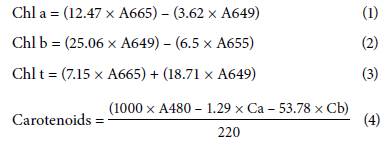Introduction
Soybean (Glycine max (L.) Merrill) is a legume of great economic importance and nutritional value. It is part of a set of agricultural activities with greater global prominence and is the fourth most consumed and produced grain only after corn, wheat, and rice (Hirakuri & Lazzaroto, 2014). Soybean cultivation has expanded in Brazil as a promising crop, with prominence initially in the south and central-east and later in the north and northeast regions (Barrozo & Rosa, 2018; Machado et al., 2018).
Some factors are essential for the crop to show good biometric and physiological development, and consequently, high productivity and quality of grains. These factors include solar radiation, water availability, and fertilization, with the latter being a decisive factor for productive success (Sediyama et al., 2012; Taiz & Zeiger, 2013; Tejo et al, 2019). However, although mineral fertilization is indispensable, it has a high cost. Thus, the use of other sources for nutrient supply for plants is becoming increasingly common (Dourado Neto et al, 2012). Adeyeye et al. (2014), in a study with soybean, demonstrate that the application of maize stover compost and N fertilizer significantly increase plant growth (plant height, number of leaves, nodes, and branches). In addition, dry matter production and number of fruits per plant are also significantly affected by different levels of those compounds.
Because of these problems, the use of organic fertilizers appears as an economically viable alternative, besides being less harmful to the environment. Organic fertilizers are a source of mineral nutrients and contribute to improvements in the biological characteristics of the soil (Freitas et al., 2012). Among the main organic fertilizers used, we can highlight organic compounds originated from the composting process as viable alternatives for use in agriculture.
Among these compounds, we can find the green coconut fiber, which is a by-product of the industrialization of coconut water. The fiber is constantly discarded incorrectly, causing negative environmental impacts. Therefore, we can consider it a prominent environmental liability (Klein, 2015). When compost is applied to crops in appropriate doses, it adds organic matter, improves soil structure and water retention, reduces the need for fertilizers and the potential for soil erosion (Mattos et al., 2011), contributing to the full development of soybean. Scientific advances in technologies for soil management, techniques for the correction of acidity, and balanced fertilization with macro and micronutrients allow crops to express their potential under the different edaphoclimatic conditions in Brazil (Freitas, 2011).
Given the above, we hypothesized that the substrate compound based on green coconut fiber helps in the development of soybean plants. Therefore, this research aimed to evaluate the influence of the green coconut fiber applied at different doses to the substrate on the initial development and gas exchange of soybean plants.
Materials and methods
Characterization of the experimental area
This experiment was carried out from August to October 2019 in a greenhouse covered with 200-micron UV plastic that favors the spread of light within the environment. The greenhouse belonged to the Phytotechnics Department located at Campus do Pici, Federal University of Ceará (UFC), in Fortaleza, Brazil. The maximum temperature was 29.4°C, while the minimum was 16.4°C, and the average relative humidity was around 32%, according to data obtained through a data logger (model U12/012, HOBO®, Marleston, Adelaide, Australia) installed in the center of the greenhouse. According to Kõppen, the local climate is of Aw type, i.e., very hot rainy tropical with predominant rains in the summer and autumn (Oliveira et al., 2013).
Experimental design and treatments
The experimental design was completely randomized in a 2x6 factorial arrangement, with two soybean cultivars (Pampeana 40RR and Pampeana 60RR), six doses of compost containing crushed green coconut considered as fiber (shell + mesocarp + endocarp) (0, 10, 20, 30, 40, and 50 t compost ha-1), and five replicates. Each replicate was made up of one plant per pot.
Obtaining the compost
The compost used in the experiment was obtained by the action of aerobic microorganisms on green coconut fiber mixed with poultry manure, in the proportion of 3:1 (v/v) and arranged under layers in rows of 3 m long, 1 m wide, and 1 m deep, under an average temperature of 27.8°C. The windrows were turned over weekly to assist oxygenation and decomposition of the material by the microorganisms.
After 7 months, the compost was sieved in a 5 mm mesh and placed to dry for 48 h in an oven with forced air circulation (model MA033/1080, Marconi®, Piracicaba, SP, Brazil) at 45°C. Then, it was weighed according to the following treatments: control (0 t ha-1), 50 g (10 t ha-1), 100 g (20 t ha-1), 150 g (30 t ha-1), 200 g (40 t ha-1), and 250 g (50 t ha-1) and mixed with the soil (4 kg per pot). For this, the doses were estimated using a soil density of 1.25 and a depth of 0.20 cm. The chemical characteristics of the compound are shown in Table 1, according to Silva (2009).
Plant growth experiments
The soybean seeds were sown in pots coated with plastic polyethylene vases containing 4 kg of soil (Red-Yellow Argisol) as classified by Lima et al. (2002). The soil was homogenized with the compost containing the green coconut fiber in its respective doses. The chemical characteristics of soil fertility are shown in Table 2, according to Silva (2009). Thinning was carried out a week after planting, leaving only one plant per pot to avoid competition for space and light, since inoculation with Bradyrizobium sp. had not been carried out.
TABLE 2 Soil fertility analysis.

OM - organic matter; BS - base saturation; CEC - cation exchange capacity; ESP - exchangeable sodium percentage; EC - electrical conductivity; V - base saturation.
The irrigation was performed manually using the water retention capacity (WRC) as a reference that was previously determined in the laboratory. The WRC was determined as described by Souza et al. (2000), considering the difference between the weight of the wet soil after saturation and free drainage, and the weight of the dried soil.
Water retention capacity was maintained daily in all pots by gravimetry, weighing them and replacing the volume of water lost by evapotranspiration, using a scale (model3/0, Songhe Tools®, São José dos Pinhais, PR, Brazil). Manual removal of weed plants was carried out throughout the experiment.
Analyzed variables
Biometric variables
During the pre-flowering period 30 d after sowing (DAS), plant height (PH), stem diameter (SD), and the number of leaves (NL) were measured. We used a measuring tape graduated in centimeters to measure the height of the plant from the bottom of the stem until the last insertion of the leaf. A digital caliper was used to measure the SD at the bottom of the stem. The NL was determined based on the count of each fully developed leaf.
At the end of the experiment at 30 DAS, the collective destruction of the plants was carried out to obtain the dry mass of the organs (dry mass of leaves, stems, and roots). The leaf area was measured using a surface integrator (LI - 3100 Area Meter, Li-Cor Inc., Lincoln, Nebraska, USA).
Shoots and roots were collected, rinsed, packaged in paper bags, and transferred to a drying oven (model MA033/1080, Marconi®, Piracicaba, SP, Brazil) at 65°C until a constant mass was obtained. The vegetative organs were weighed using a precision scale (model AL200, Marte®, São Paulo, SP, Brazil) for obtaining the respective dry mass. The total dry mass of the plants was determined by adding the dry mass of the leaves, stem, and roots.
Physiological variables
The analyses of physiological variables were performed 30 DAS (pre-flowering period). SPAD was used to measure the relative chlorophyll index of the last three fully developed leaves located in the central leaflet. At the end of the experiment, photosynthetic pigments were also evaluated (contents of chlorophyll a, b, total, and carotenoids in leaves), following the methodology described by Wellburn (1994).
The values of chlorophyll a (Chl a), b (Chl b), total (Chl t), and carotenoids were estimated using the following equations:
where A represents the absorbance at a respective wavelength with values obtained in ml-1 and expressed in mg g-1 of dry matter (DM).
The gas exchange analysis was carried out between 08:00 am and 11:00 am on the third fully expanded leaf using an infrared gas analyzer (model LCI, BioScientfic, Great Amwell, England). The liquid photosynthetic rate (A, μmol CO2 m-2 s-1), stomatal conductance (gs, mol H2O rn2 s-1), internal CO2 concentration (Ci, μmol CO2 mol-1), and transpiration (E, mmol m-2 s-1) were estimated. From the A/E ratio, we calculated the water use efficiency (WUE).
Statistical analysis
The results of the evaluated variables were subjected to an analysis of variance (ANOVA) and to the Shapiro-Wilk normality and homogeneity tests. When the variables were significant for the F test, they were subjected to a regression analysis and comparison of means by the Tukey's test, using the computer program RStudio. We made the graphics using SigmaPlot version 11.0.
Results and discussion
Biometric variables
The results of the analysis of variance (Tab. 3) showed that for the cultivars tested, only the variables stem diameter (SD) and root dry mass (RDM) did not show significant responses, while the others showed a significance of 1% and 5% probability by the F test. Regarding the dose factor, all the variables tested were influenced at the level of 1% probability, showing a highly significant effect on the development of soybean plants. Regarding the interaction between factors, only the variables plant height (PH) and RDM showed significant responses at the 5% probability level by the F test.
TABLE 3 Summary of the analysis of variance for the variables plant height (PH), leaf area (LA), number of leaves (NL), stem diameter (SD), leaf dry mass (LDM), stem dry mass (SDM), and root dry mass (RDM) in two soybean cultivars grown under different doses of green coconut fiber organic compound.

SV - source of variation; DF - degree of freedom; CxD - cultivar x doses Interaction; CV - Coefficient of variation. * ** Significant at 5% and 1% by the Ftest, respectively, ns - not significant.
Regarding the variable plant height (Fig. 1 A), two quadratic equations were adjusted. We observed that the cultivar 1 (Pampeana 60RR) showed superiority at all tested doses compared to cultivar 2 (Pampeana 40RR). The maximum height for the cultivar Pampeana 60RR was 79.35 cm when the plants were fertilized with a dose of 27.401 ha-1, whereas the cultivar Pampeana 40RR was 36.33 cm under a dose of 29.50 t ha-1. After these doses, there was a reduction in the height of the plants, possibly due to a toxic effect, or an imbalance of a certain nutrient provided by the compound. Making a comparison between the maximum points of the two cultivars, we observed an increase of more than 100% of the cultivar Pampeana 60RR compared to the cultivar Pampeana 40RR. Hence, for this variable, 'Pampeana 60 RR' was highly responsive to the use of a coconut fiber-based compound.
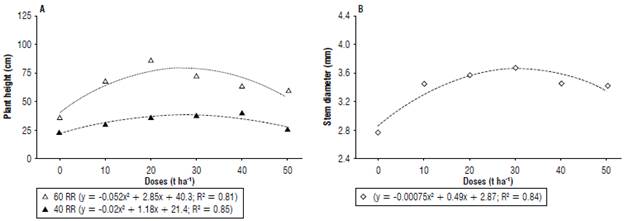
FIGURE 1 A) Plant height and B) stem diameter in two soybean cultivars (Pampeana 60RR and Pampeana 40RR) grown at different doses of compost containing green coconut fiber.
Regarding the effect of the doses for increasing the stem diameter (Fig. 1B), a quadratic equation for the data was adjusted, finding a maximum point of 3.67 mm when the plant was fertilized with a dose of 32.661 ha-1. When making a comparison with dose 0 that had a maximum point of 2.51 mm, there was an increase of 31.60%.
Analyzing these results, we could observe the influence of the doses of the compound on plant growth and the differentiation of meristematic cells of the vascular cambium and the bark. Oliveira et al. (2018) found similar results when working with cherry tomato plants under organic fertilization in different cultivation environments. They verified an increase in plant height depending on the application of fertilizers and the evaluation periods. According to Camargo (2012), the efficient use of organic fertilizers provides improvements in the physical, chemical, and biological properties of the soil that can assist in the proper growth of plants and, consequently, promote better crop yields.
Araujo et al. (2012) working with sources of organic matter in castor bean BRS Energia, report significant results with the use of sources of organic matter for the stem diameter.
In a study conducted by Castro et al. (2016), the authors find that for capimpalisade there is a linear increase in plant height depending on the application of cattle manure. Therefore, the higher results for plant height found in our research are associated with the availability of nutrients provided by the compound used in the experiment, especially Ca and Mg (growth-related nutrients) (Tab. 1). However, higher levels caused physiological disorders that hinder the development of the plants, especially for the cultivar Pampeana 40 RR.
For leaf area, the cultivar 60RR showed an average of 346.08 cm2, significantly higher than the cultivar 4 0RR that showed an average value of 288.04 cm2. Comparing these averages, we observed an increase of 16.78% for the cultivar 60RR compared to cultivar 40RR (Fig. 2A). Regarding the effect of doses on the increase of leaf area, a quadratic equation for the data was adjusted, finding a maximum point of 406.16 cm2 when plants were fertilized with a dose of 32.7 t ha-1 (Fig. 2B). When we compared the dose 0 that showed a value of 155.22 cm2, there was an increase of 61.78% in the maximum point. This result confirmed the values of plant height since there was possible toxicity. Therefore, there was a reduction in plant growth for the number of leaves emerging, influenced by the application of higher doses of the compound.
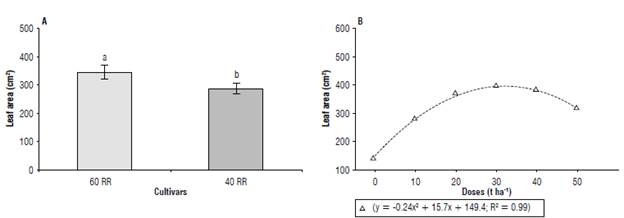
FIGURE 2 A) Leaf area of soybean cultivars Pampeana 60RR and Pampeana 40RR B) grown under different doses of compost containing green coconut fiber. Values are means of five plants (± standard error). Means followed by the same letters do not differ according to the Tukey's test at 5% probability.
The increase in leaf area improves a plant's capacity to harness solar energy to carry out photosynthesis. Therefore, a higher leaf area will probably increase productivity since it is directly associated with photosynthetic rates, and this, in turn, is directly related to production. In that sense, the cultivar Pampeana 60RR again showed increased results. It is noteworthy that, although highly responsive to fertilization with the compost from green coconut fiber, the cultivars demonstrated toxic effects at the two highest levels of fertilization. This toxicity maybe associated with a greater amount of Mn and Cu (Tab. 1).
The dry mass of leaves of the cultivar 60RR showed an average of 1.50 g, being superior to cultivar 40RR that showed an average of 1.30 g (Fig. 3A). Comparing these averages, an increase of 13.34% was seen for the effect of doses on the increase of the dry mass of leaves. A quadratic equation was adjusted to the data, and we found a maximum point of 1.72 g when the plant was fertilized with a dose of 35.00 t ha-1 (Fig. 3B). When making a comparison with dose 0 (0.351 g), there was an increase of 79.65%.
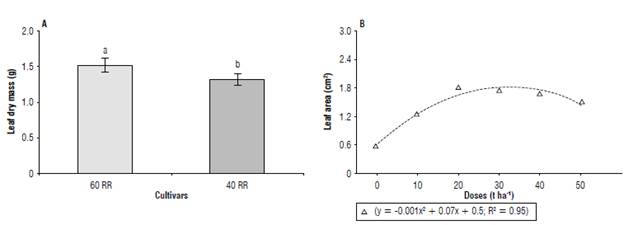
FIGURE 3 A) Leaf dry mass of soybean cultivars Pampeana 60RR and Pampeana 40RR B) under different doses of the organic compound of green coconut fiber. Values are the means of five plants (± standard error). Means followed by the same letters do not differ according to the Tukey's test at 5% probability.
Lima et al. (2001) observe a higher dry mass of leaves that increase on average 0.3 and 1.1 g per plant. These results are directly related to the height of the plant since plants may generally have a higher number of leaves to carry out photosynthesis and meet the demand for assimilates.
For the dry mass of the stem, we found that the cultivar 60RR showed an average of 0.87 g, superior to the cultivar 40RR that showed an average of 0.58 g, representing an increase of33.34% (Fig. 4 A). Concerning the effect of doses on the increase of the dry matter of the stem, a quadratic equation was adjusted to the data resulting in a peak of 0.99 g when plants were fertilized with a dose of 32.50 t ha-1 (Fig. 4B). When comparing with the dose 0 (0.170 g) at the maximum point, there was an increase of 82.82%.
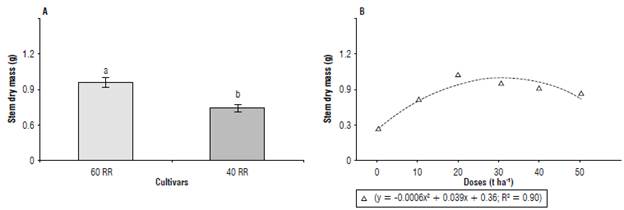
FIGURE 4 A) Stem dry mass of the of soybean cultivars Pampeana 60RR and Pampeana 40RR B) under different doses of the organic compound of green coconut fiber. Values are the means of five plants (± standard error). Means followed by the same letters do not differ according to the Tukey's test at 5% probability.
We can associate the reduction of several of the variables analyzed, such as stem dry mass, leaf dry mass, and leaf area, with the increase of the doses by the values of Zn (Tab. 1). Zinc is required in very low amounts by the plants (Marschner, 2012), so with the increase in the doses of the coconut fiber compound, this amount rose to values that caused toxicity in soybean plants that culminated in the reduction of plant development, as a whole.
The dry mass distribution in the plant is a variable that allows a discussion about the process of product translocation resulting from the photosynthetic process, facilitating the understanding of the plant response in terms of productivity. According to Lima et al. (2010), when evaluating the growth of coconut (Cocos nucifera) plants as a function of organic fertilization, the dry mass of the stem was significantly influenced by the application of organic matter combined with mineral fertilizers P and K.
Therefore, regarding the dry mass of the shoot (dry mass of leaves + dry mass of the stem), we observed that the cultivar 60RR is more responsive to fertilization, demonstrating that the organic compound is a material with great potential in comparison to chemical fertilization. The fact that it showed a higher dry mass of the shoot suggests a better mechanism for translocation of photo-assimilates and greater efficiency of nutrient absorption. The doses close to 30 t ha-1 were the ones that provided the highest values for this and other growth variables, such as stem diameter, leaf dry mass, and leaf area, indicating that in this dose, the supply of nutrients, as well as the balance between them, is the most appropriate.
Regarding the dry mass of roots (Fig. 5), two quadratic equations were adjusted. We observed that the cultivar Pampeana 40RR showed higher values up to the dose of 30 t ha-1 compared to the cultivar Pampeana 60RR.
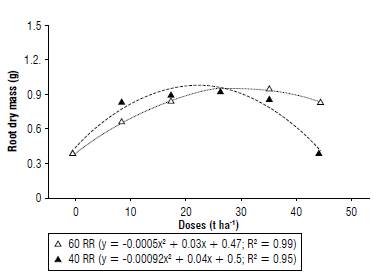
FIGURE 5 Root dry mass of soybean cultivars Pampeana 60RR and Pampeana 40RR grown under different doses of compost including green coconut fiber.
The maximum point of the dry mass of roots found for the cultivar 60RR was 0.92 g when the plants were fertilized with a dose of 301 ha-1, while the cultivar 40RR showed an average of 0.93 g with the dose of 21.74 t ha-1.
The ideal root system is the one that explores the largest volume of soil, allowing the plant to explore a larger soil area (Parfitt et al, 2017). The growth of the root system of plants is essential for the absorption of nutrients and better performance in translocating them to the vegetative organs. This can be seen by the results of the growth and accumulation of dry matter in the root, especially in the cultivar Pampeana 60 RR.
A possible explanation for this decrease in plant growth when subjected to higher doses (40 or 501 ha-1) of compost based on green coconut fiber is the number of nutrients present in the soil after adding the compost. In practical terms, nutrients play important roles in plants; however, the necessary amount, especially of micronutrients in the soil, is small due to the low requirement of this nutrient by crops (Marschner, 2012). So, this greater number of micronutrients in the soil with doses from 30 t ha-1 when the treatments were applied could have caused the opposite effect that culminated in a reduction in most of the growth variables evaluated.
Physiological variables
The analysis of variance for the values of chlorophyll a, b and total, and carotenoids is shown in Table 4. Only the variable carotenoids showed no significant response, while the others showed a 1% significance probability by the F test. Regarding the doses factor, only chlorophyll b showed no significant response, and the other variables tested were influenced at the level of 1% probability. Concerning the interaction between factors, only the variable chlorophyll a showed a significant response at the level of 1% probability by the F test.
TABLE 4 Summary of analysis of variance for the variables chlorophyll a (Chi a), chlorophyll b (Ch b), total chlorophyll (Chi t), and carotenoids in two soybean cultivars grown under different doses of compost containing green coconut fiber.

SV - source of variation; DF - degree of freedom; C x D - cultivar x doses interaction; CV - coefficient of variation. *, ** Significant at 5% and 1% by the F test, respectively. ns - not significant.
For chlorophyll a, two quadratic equations were adjusted, finding a maximum point of 4.90 when plants were fertilized with a dose of 41.6 t ha-1 for cultivar 60RR, and a maximum point of 6.8 when plants were fertilized with a dose of 40.60 t ha-1 for cultivar 40RR (Fig. 6A). For chlorophyll b, the cultivar 60RR showed an average value of 6.62 which is higher than the cultivar 40RR that showed an average value of 4.07. There was an increase of 38.51% when comparing these averages (Fig. 6B).
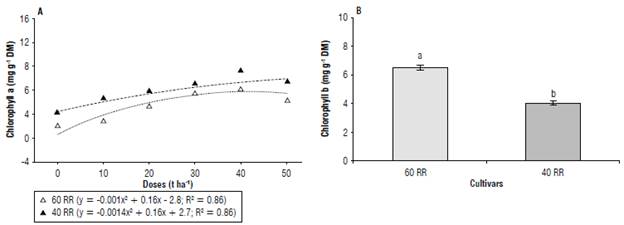
FIGURE 6 A) Chlorophyll a and B) chlorophyll b from soybean cultivars Pampeana 60RR and Pampeana 40RR grown under different doses of compost containing green coconut fiber. Values are the means of five plants (± standard error). Means followed by the same letters do not differ according to the Tukey's test at 5% probability.
Regarding total chlorophyll, we found that the cultivar 60RR showed an average of 11.10. This cultivar obtained higher values compared to the cultivar 40RR that showed an average of 7.73. An increase of 30.36% was observed when comparing these averages (Fig. 7A). Regarding the variable carotenoids, we found that there was no significant difference between cultivars. Concerning the effect of doses, a quadratic equation for the data was adjusted, and we found a maximum point of 1.60 when the plants were fertilized with a dose of33.341 ha-1. When comparing the dose 0 (0.40) with the maximum point, there was an increase of 78.02% (Fig. 7B).
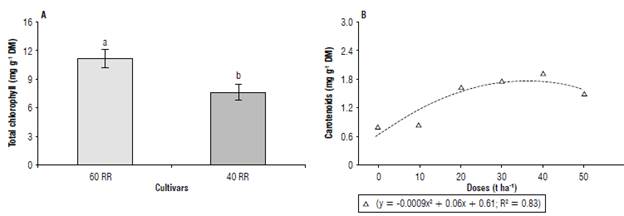
FIGURE 7 A) Total chlorophyll and B) carotenoids of soybean cultivars Pampeana 60RR and Pampeana 40RR grown under different doses of compost containing green coconut fiber. Values are the means of five plants (± standard error). Means followed by the same letters do not differ according to the Tukey's test at 5% probability.
Chlorophyll a is the pigment used to perform photochemistry (the first stage of the photosynthetic process), while the other pigments assist in the absorption of light and the transfer of radiant energy to the reaction centers. Thus, they are called accessory pigments. The main accessory pigments also include other types of chlorophylls, such as chlorophyll b that is present in higher plants, green algae, and some bacteria (Taiz & Zeiger, 2013).
Chlorophyll is one of the main factors related to the photosynthetic efficiency of plants and, consequently, to growth and adaptability to different environments and adverse conditions caused by different types of stress. The apparent differences in the color of the plants are due to the presence and distribution of other associated pigments, such as carotenoids and anthocyanins that always accompany the chlorophylls. In plants, carotenoids are located in the plastids where they are synthesized and have a non-enzymatic antioxidant function. Anthocyanins are flavonoid compounds with various functions in plants, like defense against abiotic stresses. Therefore, these compounds have a fundamental role in combating reactive oxygen species (ROS) (Barbosa et al, 2014).
Based on the results obtained, we concluded that for the photosynthetic analysis, the cultivar 60RR was more responsive to the assimilation of photons that reflected its photosynthetic metabolism and the greater production of photoassimilates and made it metabolically more efficient than the cultivar 40RR. The essential role of fertilization with residues of green coconut fiber provided nutrients and good physical, chemical, and biological conditions so that soybean plants could increase the levels of photosynthetic pigments when compared to the treatment without fertilization. However, as has been shown, higher doses caused negative effects on the physiological development of the soybean plant.
In the analysis of variance shown in Table 5, we saw that for the cultivar factor, only the variables photosynthesis (A) and water use efficiency (WUE) did not show significant responses, while the others showed a significance of 1% and 5% probability by the F test. Regarding the dose factor, only the variable stomatal conductance (gs) did not show a significant response. Regarding the interaction between factors, only the variables A, gs, and transpiration (E) showed significant responses at the level of 1% probability according to the F test.
TABLE 5 Summary of the analysis of variance for the variables photosynthesis (A), stomatal conductance (gs), transpiration (E), internal carbon (C,), and water use efficiency (WUE) in soybean plants grown under different doses of compost containing green coconut fiber.

SV - source of variation; DF - degree of freedom; C x D - cultivar x doses Interaction; CV - coefficient of variation. * ** Significant at 5% and 1% by the F test, respectively. ns - not significant.
When evaluating the photosynthesis (Fig. 8A) two regression models were adjusted. For the cultivar 60RR, a quadratic model was adjusted, while for the cultivar 40RR a linear model was adjusted. The maximum point found for cultivar 60RR was 10.08 when plants were fertilized with a dose of 32 t ha-1. For cultivar 40RR, there was an increment of 1.83 for each 1 t ha-1 of green coconut fiber that was added. When evaluating stomatal conductance (Fig. 8B), we adjusted a quadratic equation for cultivar 60RR and found a maximum point of 0.28 when the plants were fertilized with a dose of 23.13 t ha-1. For the cultivar 40 RR, there was an increase of 0.0035 for each 1 t ha-1 added.
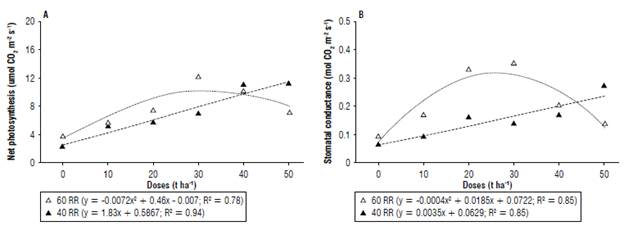
FIGURE 8 A) Net photosynthesis B) and stomatal conductance of soybean cultivars Pampeana 60RR and Pampeana 40RR grown under different doses of compost containing green coconut fiber.
For transpiration, we adjusted a quadratic equation and found a maximum point of 2.86 when the plants were fertilized with a dose of 26.76 t ha-1. For the cultivar 40RR, we observed an increment of 0.023 for each increase of 1 t ha-1. We observed the highest average at the dose of 50 t ha-1 with a value of 2.8 (Fig. 9A). Regarding the effect of doses for internal carbon, a quadratic equation for the data was adjusted, finding a minimum point of276.50 when the plants were fertilized with a dose of 39.52 t ha-1. When we compared dose 0 (337) with the minimum point, there was a reduction of 18.5% (Fig. 9B).
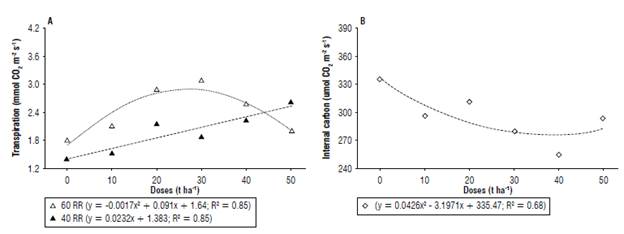
FIGURE 9 A) Transpiration and B) internal carbon of soybean cultivars Pampeana 60RR and Pampeana 40RR grown under different doses of compost containing green coconut fiber.
When analyzing the water use efficiency that was adjusted to a quadratic equation to the data, we found a peak of 3.83 when plants were fertilized with a dose of 39.09 t ha-1. When this dose was compared to dose 0 that showed a value of 1.47, there was an increase of 61.61 % (Fig. 10).
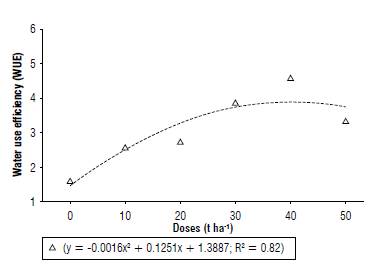
FIGURE 10 Water use efficiency (WUE) in soybean cultivars Pampeana 60RR and Pampeana 40RR grown under different doses of compost containing green coconut fiber.
Gondim et al. (2015) find higher values of stomatal conductance in the presence of mineral fertilization when evaluating the effects of doses of manure in the presence and absence of mineral fertilization on gas exchange in beet plants. These results might be explained by the presence of potassium. The rate of net CO2 assimilation, transpiration, stomatal conductance, and intercellular CO2 concentration are correlated parameters that serve to diagnose physiological changes in plants when subjected to adverse conditions such as low and high amounts of nutrients (Gondim et al., 2015).
In general, gas exchange data suggest the superiority of cultivar 60RR when compared to cultivar 40RR. For net photosynthesis rates, the highest values can be correlated with the fact that this cultivar had a larger leaf area and a higher number of leaves and plant height; all these values contribute to better photosynthetic performance. We also observed that this same material had a more efficient stomatal regulation, a fact observed in Figure 8B for the higher values of the stomatal conductance. Therefore, high levels of carbon dioxide influx provided higher photosynthetic rates.
For the internal concentration of CO2, the cultivar 40RR showed lower values. This fact indicated that there was greater assimilation of CO2. However, it did not influence higher rates of photosynthesis. The cultivar 60RR showed higher accumulations of internal carbon, differing from the other genetic material. Nevertheless, due to its better physiological responses, it showed greater assimilation of carbon. For water use efficiency, the responses to the significant effect of doses demonstrated that there was an increase in these rates through fertilization with the compost.
Miyake et al. (2017), when evaluating the substrates and nitrogen fertilization in the production of yellow passion fruit seedlings, find that the coconut fiber-based substrate favored the relative chlorophyll index when compared to the commercial substrate Vivatto®, especially from the dose of 300 mg dm-3. These results are similar to what was found in our study since the use of doses from 10 t ha-1 increased this parameter for both soybean cultivars tested. Chlorophyll a is responsible for photon capture, while chlorophyll b constitutes accessory pigments in the photosynthetic apparatus, so they are closely related to the photosynthetic process and gas exchange itself.
Therefore, a possible explanation for the increase, not only in the amount of chlorophyll a, but also in gas exchange (A, gs, and E) may be associated with an increase in nutrients, especially N and Mg when the plants were subjected to higher doses of the green coconut fiber compound. It is worth mentioning that cultivar 60RR showed a positive response up to a certain dose of organic compost, while cultivar 40RR showed linear increases in gas exchange due to the increment in the added doses, thus, proving to be more nutritionally demanding.
Conclusions
The composition of green coconut fiber positively influenced the biometric and physiological characteristics of the soybean cultivars studied, and the recommended dose of the compound is 30 t ha-1.
The cultivar Pampeana 60RR is more responsive to fertilization as it showed higher values of height, leaf area, number of leaves, diameter of the stem, dry mass of the leaves, and dry mass of the stem.
In general, the gas exchange of cultivar Pampeana 60RR was higher than the cultivar 40RR, indicating that it shows greater adaptability to the climatic conditions of the Brazilian northeast region.














